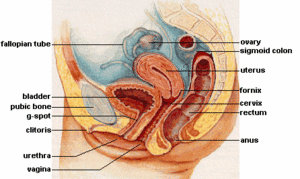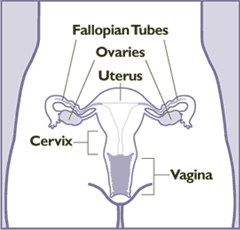Fallopian tube
|
|
The Fallopian tubes or oviducts are two very fine tubes leading from the ovaries of female mammals into the uterus. They are named after their discoverer, the 16th century Italian anatomist, Gabriele Falloppio.
There are two Fallopian tubes, attached to either side of the cranial end of the uterus, and each terminating at or near one ovary.
When an ovum is developing in an ovary, it is encapsulated in a sac known as a ovarian follicle. On maturity of the ovum, the follicle and the ovary's wall rupture, allowing the ovum to escape and enter the Fallopian tube. There it travels toward the uterus, pushed along by movements of cilia on the inner lining of the tubes. This trip takes hours or days. If the ovum is fertilized while in the Fallopian tube, then it normally implants in the endometrium when it reaches the uterus, which signals the beginning of pregnancy. Occasionally the embryo implants into the Fallopian tube instead of the uterus, creating an ectopic pregnancy.
The Fallopian tubes are not homologous to the vas deferens or any other structure in males. Embryos have two pairs of ducts to let gametes out of the body; one pair develops in females into the Fallopian tubes, uterus and vagina, while the other pair develops in males into the epididymis and vas deferens. Normally, only one of the pair of tubes will develop while the other regresses and disappears in utero.
The Fallopian tubes are not directly attached to the ovaries, but open into the peritonial cavity (essentially the inside of the abdomen); they thus form a direct communication between the peritoneal cavity and the outside via the vagina.
In humans, the Fallopian tubes are about 7–14 cm long.
See also
| Reproductive system |
| Female: Cervix - Clitoris - Clitoral hood - Fallopian tubes - Bartholin's glands - G-spot - Hymen - Mammary glands - Ovaries - Skene's glands - Urethra - Uterus - Vagina - Vulva |
| Male: Bulbourethral glands - Cowper's glands - Ejaculatory duct - Epididymis - Foreskin - Frenulum - Penis - Prostate - Scrotum - Seminal vesicles - Spermatic cord - Testes - Urethra - Vas deferens |


